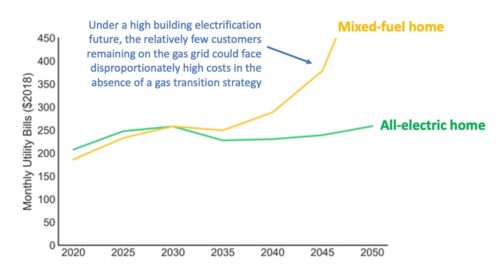
A new E3 study for the California Energy Commission demonstrates why the state needs a transition strategy for its retail natural gas distribution system, as it aims to achieve its ambitious climate goals by midcentury.
Natural gas is an integral part of the energy system in California, with more than 80 percent of all homes connected to the natural gas grid. The question of how to reduce carbon emissions from natural gas use in buildings is thus a crucial one as California looks toward strategies for meeting its climate goals.
In this study, E3 evaluated two strategies for reducing carbon emissions from California buildings: building electrification and renewable natural gas. E3 found that building electrification is likely to be a lower-cost and lower-risk strategy for reducing carbon emissions from buildings in California. E3 also found that, particularly under a high building electrification future, customers remaining on the natural gas system could face disproportionately high costs in the absence of a gas transition strategy.

The study, which builds on E3’s 2018 deep decarbonization report for the CEC, used E3’s PATHWAYS model to evaluate economy-wide deep decarbonization scenarios and examine possible futures for the natural gas system. E3 also partnered with co-authors from the Advanced Power and Energy Program at the University of California, Irvine, to examine the costs of renewable natural gas and to evaluate the impact of these deep decarbonization scenarios on air quality.
The draft study results were first presented in June 2019 at a California Energy Commission public workshop and were subsequently finalized after incorporating feedback from stakeholders. E3 experts Dan Aas, Amber Mahone, Zack Subin, and Snuller Price contributed to this study.
In September 2019, the nonprofit Gridworks published policy recommendations in a related report, “California’s Gas System in Transition: Equitable, Affordable, Decarbonized and Smaller,” which draws from E3’s analysis of the PG&E system.
The final report for this study can be downloaded here, and the appendices can be downloaded here.
Media
UtilityDive, “California natural gas costs could spike as state decarbonizes: E3, UC Irvine“
Los Angeles Times, “Cow poop could fuel California’s clean energy future. But not everyone’s on board“
S&P Global Market Intelligence, “Calif. decarbonization may create thorny cost issues for gas systems” (paywall)
NRDC Expert Blog (Pierre Delforge & Merrian Borgeson), “Study: CA Needs a Safe, Managed Transition Away from Gas“
NRDC Expert Blog (Merrian Borgeson), “Protecting Workers and Communities Requires Gas Planning“
Environmental Defense Fund Energy Exchange Blog (Michael Colvin), “How to decarbonize California’s economy without breaking the bank“
Environmental Defense Fund Energy Exchange Blog (Michael Colvin), “Strategies for smarter, cleaner buildings in California“


